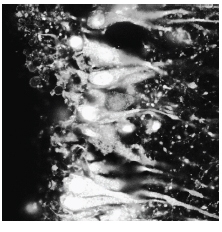RNA from a Single Cell in its Natural Environment
For the first time, researchers have been able to grab all the RNA from a single living cell while it is still in its natural microenvironment—that is, tight and cozy with its neighboring cells.

The new method provides a unique way to study cell function and could be developed into a new way to study the effects of drugs inside the body. The researchers who developed the tool used it to show that a neuron interacting with its neighbors expresses a very different set of genes than a neuron grown in culture (a common way of studying the brain cells). In fact, many more genes were turned on in individual neurons grown in culture than those growing in their natural setting.
Single-cell analyses provide much more insight into the biology of healthy and diseased cells, says study author James Eberwine, a biochemist at the University of Pennsylvania. For instance, if studying Alzheimer’s disease, the new method could be used to study the individual cells that neighbor the amyloid plaques associated with the condition. “You could see if there is a direct effect of that plaque on those cells,” says Eberwine.
Or, to ask basic questions about brain function, one could study how stimulating one neuron affects the gene expression of a neuron it communicates with through a synapse. Such a question was previously virtually impossible to ask, says Eberwine. He and colleagues show that their new single-cell RNA analysis technique can capture the RNA of just a single neuron while that neuron is still in synaptic contact with its neighbors. The team used their new method to grab the RNA from a single neuron from pieces of brain from mice as well as from human patients who had recently undergone brain surgery.
Their results were published in Nature Methods on Sunday.
In general, studying the molecular makeup of single cells is tricky. Most lab tests require much more starting material than one cell can offer. But while analyzing a large number of cells at once enables lots of experiments, it tends to muddy the results because researchers are taking an average of what is happening in each cell. Even cells taken from the same bit of an organ like the heart, liver, or brain can be different at the molecular level, with a different makeup of genes that are turned on, or expressed as proteins or other bio-molecules.
This is an important consideration for medicine. Take, for instance, a tumor. Two different cells in the same tumor can have different DNA mutations and other molecular changes that contribute to their deranged state. So when scientists in a hospital’s pathology lab studies a patient’s tumor to see whether it has a particular mutation that can be treated with a particular drug, they may not know if the drug they suggest will actually attack all or even most of the cells in that tumor.
Single-cell analyses can also be used to develop non-invasive ways to monitor cancer (see “Finding Cancer cells in the Blood”) and to know the genome of a mother’s egg before it is used in in vitro fertilization (see “Single-Cell Genomics Could Improve IVF Screening”).
The new RNA-focused method starts with an engineered molecule or “tag” that can make its way into a cell without disrupting the cell’s membrane. The tags enter many cells but do not grab onto RNA until they are activated by light. The researchers can then use a laser beam to activate the tags in only a single cell. A few more steps of molecular biology and the researchers have a pool of RNA that came from just a single cell.
Keep Reading
Most Popular
Large language models can do jaw-dropping things. But nobody knows exactly why.
And that's a problem. Figuring it out is one of the biggest scientific puzzles of our time and a crucial step towards controlling more powerful future models.
The problem with plug-in hybrids? Their drivers.
Plug-in hybrids are often sold as a transition to EVs, but new data from Europe shows we’re still underestimating the emissions they produce.
Google DeepMind’s new generative model makes Super Mario–like games from scratch
Genie learns how to control games by watching hours and hours of video. It could help train next-gen robots too.
How scientists traced a mysterious covid case back to six toilets
When wastewater surveillance turns into a hunt for a single infected individual, the ethics get tricky.
Stay connected
Get the latest updates from
MIT Technology Review
Discover special offers, top stories, upcoming events, and more.